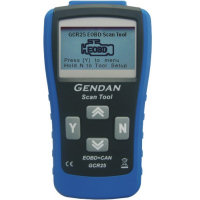What is "EOBD"?
EOBD is an abbreviation of European On-Board Diagnostics
All petrol cars sold within Europe since January 1st 2001 and diesel cars
sold since January 1st 2004 must have on-board diagnostic systems to monitor
engine emissions.
These systems were introduced in line with European Directive 98/69/EC
to monitor and reduce emissions from cars. All such cars must also have
a standard 16-pin EOBD diagnostic socket that provides access to this
system.
As a result of this it is now possible for a home user, enthusiast or small garage
to afford low-cost tools such as our GCR05
and GCR10 code readers to read
engine management fault codes, where previously very expensive workshop
tools or a trip to the dealership would have been required.
What are OBD-I, OBD-II and EOBD2?
On-Board Diagnostics, or OBD, was the name given to the early emission control
and engine-management systems introduced in cars. There is no single
OBD standard - each manufacturer often using quite different systems
(even between individual car models).
OBD systems have been developed and enhanced, in line with United
States government requirements, into the current OBD-II standard.
The OBD-II Federal requirements apply to cars sold within the USA from
1996, but do not apply to cars sold outside the USA - even those made
by American manufacturers.
EOBD is the European equivalent of the American OBD-II standard.
The two are essentially the same, but the European standard was implemented
much later, and applies to petrol cars sold in Europe from 2001, diesels
from 2004.
EOBD2 is not a new version of EOBD.
EOBD2 tends to refer to manufacturer-specific features available on
some OBDII/EOBD tools to access additional parameters/information from
a car, over and above the normal parameters and information available
within the EOBD/OBDII standard. There are, as such, no 'EOBD2 cars',
i.e. cars that require an EOBD2 tool to access their diagnostics information.
EOBD Languages
Although EOBD is a standard, it is not a single 'language', but a combination
of 5 main languages. Different car manufacturers use different
languages when their cars speak to diagnostic tools.
Almost all of our tools speak all of the languages, so you don't
need to worry about working out which the car is using.
The languages are listed below:
|
 |
- PWM
- This was the language used on most petrol Ford cars from 2001 (and
some back as far as 1997) up to around 2003.
- VPW
- This is the language used on many Chrysler and Isuzu vehicles.
- ISO9141-2
/ KWP2000 - ISO and KWP were the languages used on most other
European and Asian vehicles from 2001 for petrol, 2004 for diesel.
Both use the same connections on the EOBD port.
- CAN
- CAN (or Controller Area Network) is the newest and fastest system,
and should be used on all new cars from 2008. Many manufacturers have
been migrating their cars to CAN since around 2003.
Most tools support not only the CAN language but also the other EOBD languages
listed above. All of the Gendan range of handheld EOBD code readers
such as our GCR25 will cover
all the EOBD languages.
What does EOBD offer from a car?
EOBD tools are able to read fault codes relating to engine management
and emissions faults on a car.
These fault codes can either be 'generic' (i.e. the same definition
applies to all car manufacturers) or manufacturer-specific. Generic
codes generally begin with P0 and Manufacturer-specific codes
with P1.
|

|
Many of our advanced testing tools provide code definitions to both P0 and P1 codes.
In addition to a fault code, EOBD standards allow the more advanced test equipment, such
as our EngineCheck Pro
system, to display readings from the engine sensors, e.g. RPM, Throttle position, Oxygen
sensor voltages, temperature sensor readings.
|
|